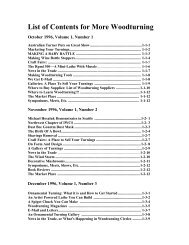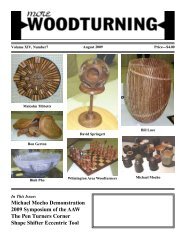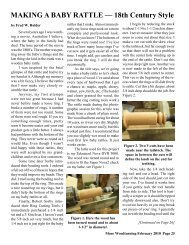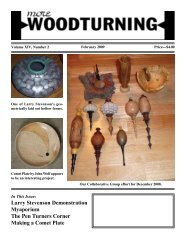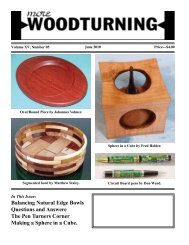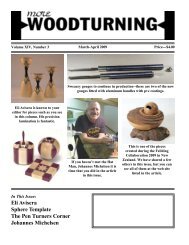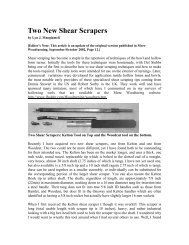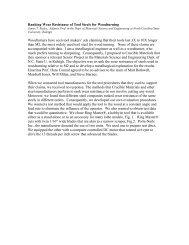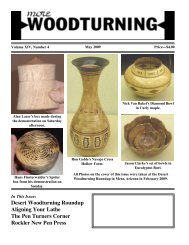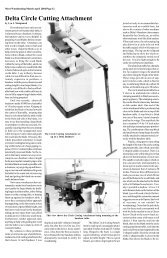Robust Lathe Review - More Woodturning
Robust Lathe Review - More Woodturning
Robust Lathe Review - More Woodturning
Create successful ePaper yourself
Turn your PDF publications into a flip-book with our unique Google optimized e-Paper software.
<strong>Robust</strong> <strong>Lathe</strong> <strong>Review</strong> Continuedfrom Page 5loose, and lowering. The banjo onthe <strong>Robust</strong> tightens on the tool restpost with a through bolt and leverwhich is side mounted, and pulls awedge in so the post is pinched intoplace. This is much more securethan any other set up I have seen. Ido have to lubricate the wedge as itisn’t stainless, and I turn a lot of wetwood, so it will rust a bit and stickif I don’t.Initially after getting the lathe,I didn’t think it had as much torqueas I had expected. I did talk to BillGrumbine about that, and he commentedthat he could even stall aVB36. Well, I considered that fora while, but it still didn’t seemlike I was getting enough torque. Italked to Brent about it, and he hadchanged the 3 phase converter toanother bigger model. He sent methe new one with a return addressprepaid shipping label, and wiringdiagram. It was fairly simple toreplace it, even for me. I like usingmy tools, but don’t like to work onthem. This made a huge difference.The converters are programmablein many ways including speeds,torque, and braking times. One thingthat I loved about the PM3520Awas that the slowest speed wasalmost zero rpm. I turn green woodbowls to final thickness, let themdry and warp, then sand and finish.It is almost impossible to keepyour hands or a sander on warpedbowls at anything over about 20 to30 rpm. Brent walked me throughthe button pushing to reprogramthe converter to do that. The newerA models, and all the B models ofthe PM are set to turn off at 50 rpm.PM did this apparently because theyare worried about the motors overPage 6 <strong>More</strong> <strong>Woodturning</strong> February 2010heating and frying the electronics.Brent mentioned this as well. I havesanded out thousands of bowls thisway, and the motor runs cooler thanwhen I am turning.The converter is mounted onthe headstock end of the lathe onthe legs, rather than on the motorhousing like the PM. You end upwith more wires running out of it,than the single one of the PM. Noproblem, just different. There is thepower cord coming in, then 3 cordsrunning out. One cord goes to theremote on/off switch, and two tothe headstock. These two are powerto the motor, and another to thespindle lock so if you turn on thelathe while the stop is engaged, themotor won’t start. I have the remoteswitch placed on the headstock,just like on the PM. I got used toit there, and if I want to have it onthe bed/square tube of the lathe, itis far enough down that I have tobend over to reach it. I do prefer tohave it on the left side because if Ihave to reach for it quickly, I don’thave to move my gouge or scraperto the other hand first. On/off switchis easy to get to, and so is reverse. Ihave never had a lathe with a digitalspeed read out, and it isn’t necessaryfor me to have one, so I don’tmiss it on the <strong>Robust</strong>.It does have 3 speed rangeswhich I think is a plus for thelathe. Slow speed range is from0 to about 500 rpm. I seldom usethis range as it is best for really bigbowls. Mostly I am on the mediumrange which is from 1 to 1800. Onechange that was made on the PMB model was the slow speed rangewent from 1500 down to 1200. Idon’t think that was a good idea.The high speed range on the <strong>Robust</strong>goes from 1 to about 2800. I couldsee having a bit higher speed rangein the 3,000 plus range, especiallyif you turn a lot of spindles, as thecurrent speed range is a bit slow forspindles less than 3 inch diameter,but it works okay for me.Belt changing isn’t as convenientas on the PM. There are 2 doorsto open to access the belt. One on topis a lift up, and the other is on theside where you have a metal panelto rotate out of the way. It is securedwith 2 thumb screws. Access isn’tas open as on the PM, especially onthe top door, and my big paws don’tfit in there all that well. This is aminor inconvenience in that it takesmaybe 30 seconds to change thebelt as compared to 15 or so on thePM. I really wish some one wouldinvent a belt changer thing like ona bicycle for the lathes where youdon’t have to open it up at all, simplylift the motor, push a lever, and thebelt moves. I don’t change pulleysoften, so again, this is a very smallproblem.Another difference is the headstockspindle shaft housing. On thePM, it is mounted into the headstockcasing. On the <strong>Robust</strong>, the shaftis mounted into a separate housingwhich is then mounted into theheadstock housing. This means thatif you need to change to a new beltor replace the headstock bearings,you can unbolt the housing from theheadstock. Much more simple. Thereis one down side to this for me. Thespindle housing has the spindle stickingout about 2 more inches from theheadstock than it does on the PM.This extra 2 inches is a longer leverarm, add to that I mount my bowlblanks by expanding the chuck intoa Forstner bit drilled recess, I amsticking out quite a ways from theheadstock (no face plates for me). Ido get some vibrations/oscillationswhen turning big bowls that I did not



